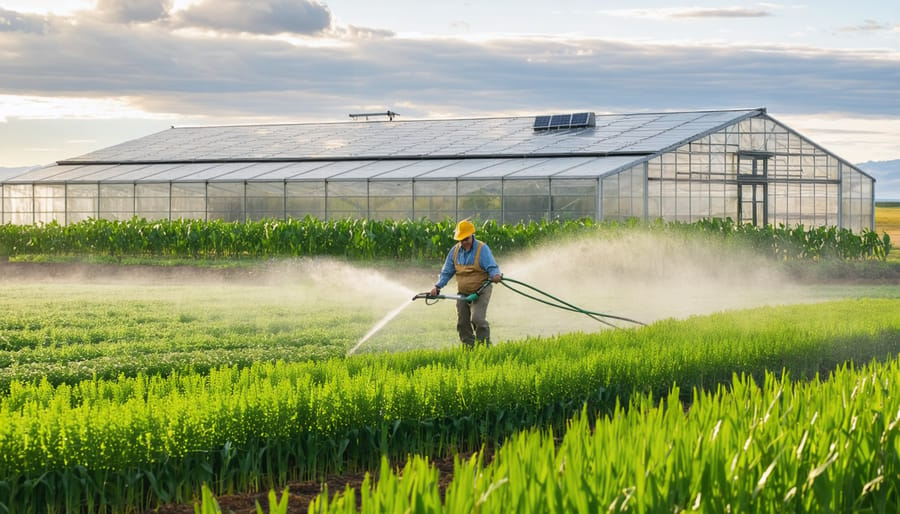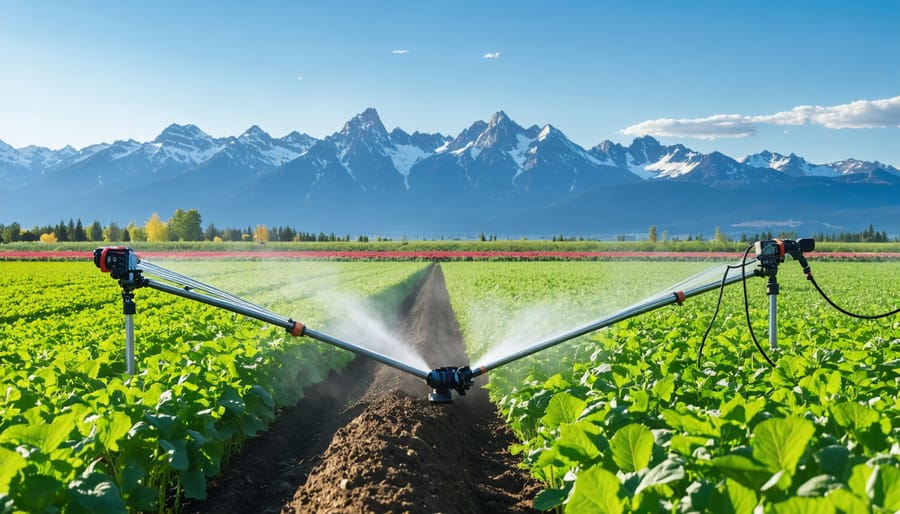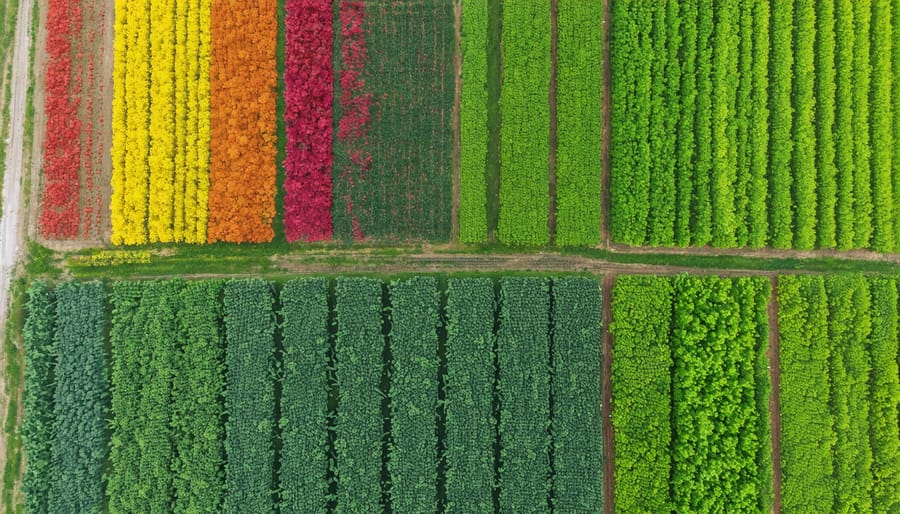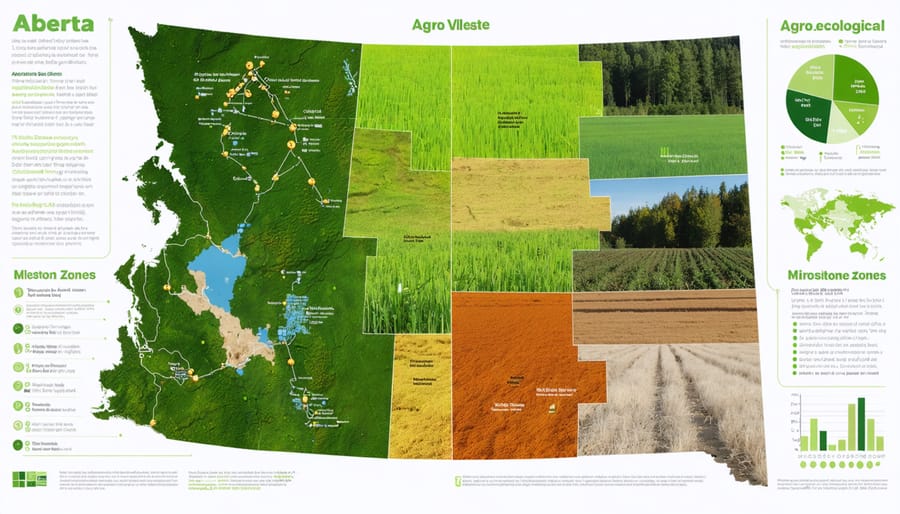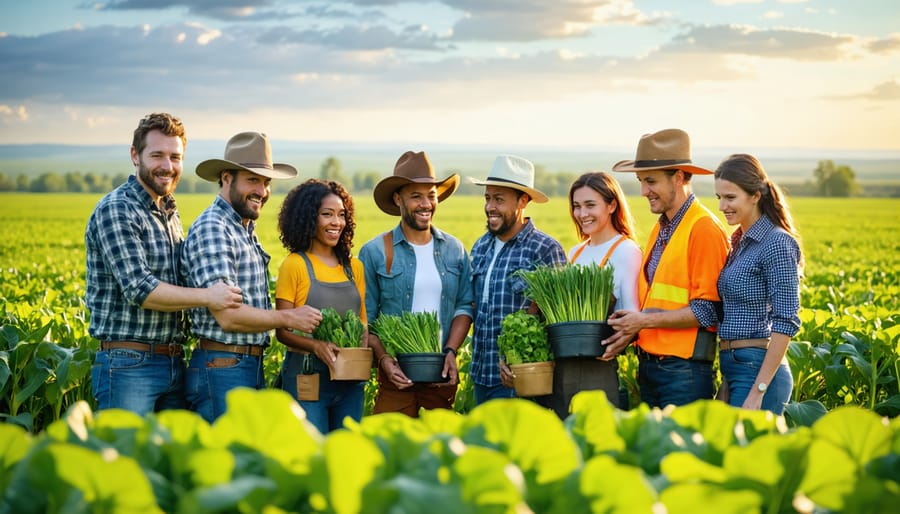Transform your farm into a climate-resilient powerhouse by implementing proven climate-smart farming practices that work specifically in Alberta’s unique conditions. Install water-efficient drip irrigation systems to reduce consumption by 30-50% while maintaining optimal soil moisture levels. Diversify crop rotations with drought-resistant varieties like hard red spring wheat and yellow peas, creating natural buffers against extreme weather patterns. Build organic matter in your soil through cover cropping and minimal tillage, increasing water retention capacity by up to 20,000 litres per hectare.
Alberta’s agricultural landscape is changing, but our farming community’s innovative spirit remains constant. By combining traditional knowledge with cutting-edge climate adaptation strategies, local producers are pioneering resilient farming methods that protect both yields and ecosystems. From Medicine Hat to Grande Prairie, farmers are proving that climate-resilient agriculture isn’t just about survival – it’s about creating stronger, more productive operations that thrive in challenging conditions.
This practical guide, developed in partnership with Alberta’s leading agricultural experts and successful local farmers, offers proven strategies to enhance your farm’s climate resilience while maintaining profitability and environmental stewardship.
Building Climate Resilience from the Ground Up
Smart Soil Management for Alberta’s Climate
Alberta’s unique climate presents both challenges and opportunities for soil management. By implementing regenerative soil management techniques, farmers can build resilience against extreme weather events while improving their soil’s health and productivity.
Cover cropping with cold-hardy varieties like fall rye and winter wheat helps protect soil during Alberta’s harsh winters while adding organic matter. These crops can be planted after harvest in September, providing crucial soil coverage during spring thaw and reducing erosion risks.
Maintaining optimal soil moisture is critical in our semi-arid climate. Incorporating composted manure and crop residues increases organic matter content, helping soil retain up to 20% more water. This practice proves particularly valuable during drought periods, which have become more frequent in recent years.
Local success stories demonstrate the effectiveness of these approaches. The Henderson family farm near Red Deer increased their soil organic matter by 2% over five years by implementing no-till practices and diverse crop rotations. Their fields now require 30% less irrigation during dry spells.
Consider these practical steps for your operation:
– Test soil organic matter levels annually
– Maintain year-round soil coverage
– Integrate livestock grazing when possible
– Use minimum tillage practices
– Monitor soil moisture levels regularly
These strategies help create a robust foundation for climate-resilient farming while preserving our valuable topsoil for future generations.

Water-Wise Growing Systems
In Alberta’s increasingly unpredictable climate, efficient water management is crucial for urban farming success. Modern water-wise growing systems combine traditional knowledge with innovative technology to maximize every drop while maintaining crop health and yield.
Drip irrigation stands out as one of the most effective water conservation methods, delivering water directly to plant roots with up to 90% efficiency. Many Alberta urban farmers have found success using automated drip systems with soil moisture sensors, which can reduce water usage by 30-40% compared to conventional irrigation methods.
Hydroponic and aquaponic systems are gaining traction in urban settings, particularly for year-round growing. These closed-loop systems use up to 90% less water than traditional farming while producing comparable yields. The Grow Calgary community farm demonstrates this effectively, using vertical hydroponic systems to grow leafy greens with minimal water consumption.
Rainwater harvesting has become essential for urban farms, with many operations installing collection systems that can store thousands of litres during wet periods. Simple solutions like rain barrels can be combined with more sophisticated underground cisterns, providing reliable water sources during dry spells.
Soil management plays a crucial role in water conservation. Adding organic matter and using mulch can increase soil water retention by up to 70%. Local urban farmers report success with wood chip mulch and compost applications, particularly in raised bed systems.
Consider implementing these water-wise strategies gradually, starting with basic rainwater collection and drip irrigation before moving to more complex systems. Remember to check local regulations regarding water collection and usage rights.
Protected Growing Solutions
Year-Round Growing Structures
Year-round growing structures are becoming increasingly vital for Alberta farmers adapting to climate change. Well-designed greenhouses and high tunnels can extend the growing season by up to four months, providing crucial protection against frost, hail, and extreme weather events while supporting climate-resilient crop selection.
For greenhouse construction in Alberta’s climate, consider implementing a double-layer polycarbonate covering with an R-value of at least 2.0, providing essential insulation during harsh winters. Supplemental heating systems, preferably ground-source heat pumps or solar thermal installations, can maintain optimal growing temperatures while minimizing energy costs.
High tunnels offer a more affordable alternative, particularly suitable for smaller operations. These unheated structures can be built for approximately $5-8 per square foot, compared to $25-30 for traditional greenhouses. Many Alberta farmers have found success with mobile high tunnels, which can be relocated to protect different crops throughout the season.
Key design considerations for our climate include:
– Snow load capacity of at least 32 kg/m²
– Strong structural supports to withstand prairie winds
– Proper ventilation systems for temperature control
– Automated irrigation systems with frost protection
– North-south orientation to maximize light exposure
Local success stories show these structures paying for themselves within 2-3 growing seasons through increased crop yields and season extension. The Cattleland Greenhouse near Strathmore demonstrates how integrating these structures with existing farming operations can create year-round growing opportunities while building climate resilience.
Remember to consult local building codes and agricultural extension services when planning your structure, as requirements vary by municipality.
Climate Control Technologies
In Alberta’s diverse climate, maintaining optimal growing conditions is crucial for year-round agricultural success. Modern innovative farming technologies have made it possible to create controlled environments that protect crops from extreme weather events while maximizing yield potential.
Smart climate control systems now integrate real-time weather data with automated greenhouse controls, allowing farmers to maintain ideal temperature and humidity levels throughout the growing season. These systems typically include programmable ventilation, misting systems, and thermal screens that work in harmony to create optimal growing conditions.
For example, the Brown family farm near Lacombe uses smart sensors that automatically adjust greenhouse ventilation based on temperature and humidity readings. Their system saved them 30% on energy costs while increasing tomato yields by 25% in their first year of implementation.
Humidity management has become particularly important for Alberta growers dealing with increasingly unpredictable weather patterns. Modern dehumidification systems help prevent fungal diseases and maintain crop quality, while automated irrigation systems ensure precise water delivery based on real-time moisture readings.
Many local farmers are now implementing simple-to-use smartphone apps that connect to their climate control systems, allowing remote monitoring and adjustment of growing conditions. These user-friendly interfaces make it easier for farmers to respond quickly to changing weather conditions, even when they’re away from their operations.
For smaller operations, cost-effective solutions like solar-powered ventilation systems and thermal mass storage are proving valuable in maintaining stable growing environments without significant energy costs.
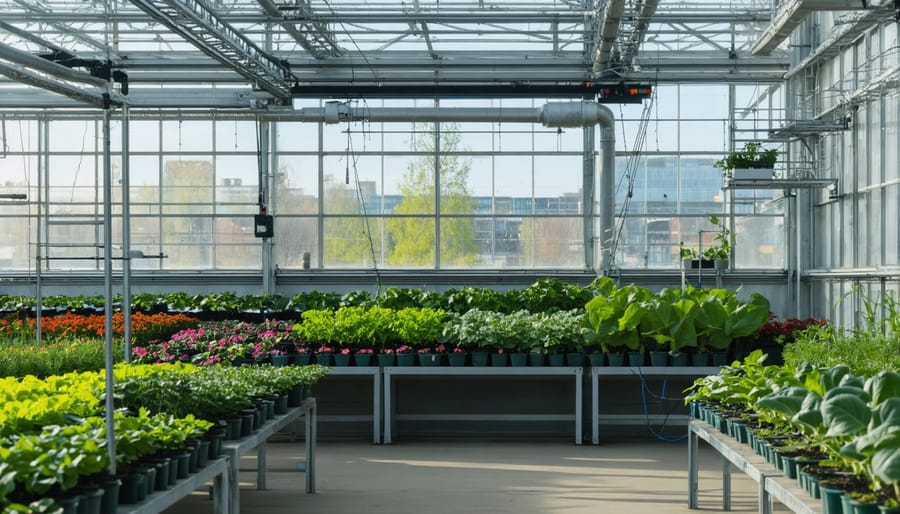
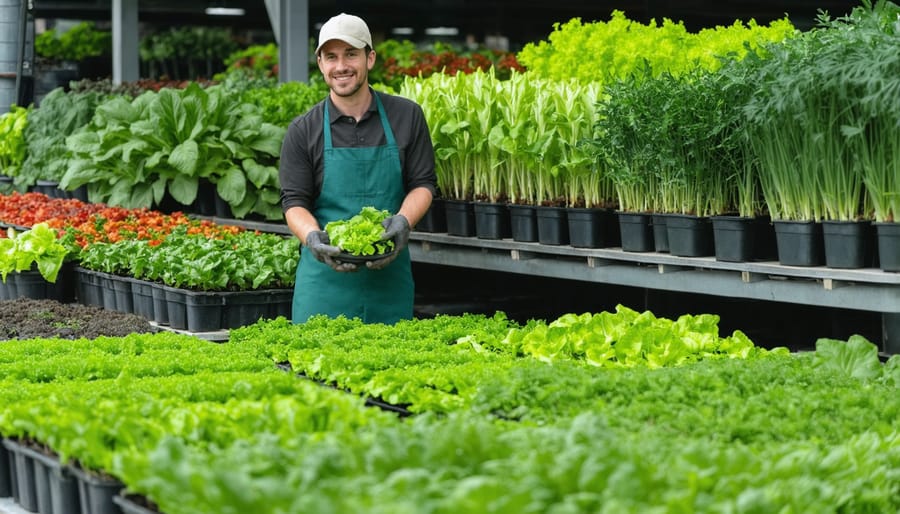
Real Success Stories: Alberta’s Climate-Smart Urban Farmers
Meet Sarah Chen, who transformed a 0.4-hectare plot in northeast Edmonton into Green Urban Farms, a thriving year-round operation that exemplifies successful adaptation strategies in urban agriculture. Using a combination of greenhouse technology and innovative water management systems, Chen’s farm produces fresh vegetables even during Alberta’s harsh winters while reducing water consumption by 60% compared to traditional farming methods.
“The key was designing our greenhouse system to capture and reuse rainwater,” explains Chen. “We’ve installed solar-powered pumps and automated irrigation controls that respond to soil moisture levels, ensuring we’re not wasting a drop.” Her operation now serves as a model for climate-smart urban farming, supplying produce to local restaurants and markets year-round.
In Calgary’s southeast district, the Martinez family runs Sunshine Urban Farm, a 0.8-hectare operation that’s revolutionizing how small-scale farms handle extreme weather events. Their innovative approach includes mobile hoop houses that can be quickly assembled or dismantled based on weather forecasts, protecting crops from unexpected hail or frost.
“We learned the hard way after losing half our crop to a hailstorm in 2019,” shares Carlos Martinez. “Now, our mobile protection systems allow us to adapt quickly to weather changes, and we haven’t lost a crop since.” The farm’s success has inspired a community of urban farmers in Calgary to adopt similar protective measures.
Red Deer’s Community Growth Project, led by veteran farmer David Thompson, demonstrates how collaborative farming can enhance climate resilience. The 1.2-hectare urban farm uses sophisticated soil monitoring technology and implements crop rotation strategies that have improved soil health and reduced susceptibility to drought.
“We’ve created a farming system that’s both productive and protective,” Thompson notes. “By incorporating cover crops and maintaining soil moisture levels through mulching, we’ve increased our soil organic matter by 3% in just two years.” The project now serves as a training ground for aspiring urban farmers, sharing knowledge about climate-resilient practices.
These success stories showcase how Alberta’s urban farmers are adapting to climate challenges while building sustainable, profitable operations. Their innovations in water management, crop protection, and soil health demonstrate that small-scale urban farming can be both resilient and productive in the face of changing climate conditions.
Integration with Urban Infrastructure
Rainwater Harvesting Systems
In Alberta’s increasingly unpredictable climate, rainwater harvesting systems offer farmers a practical solution for water security. These systems can range from simple rain barrels to sophisticated collection networks that capture thousands of litres during our wet seasons.
A basic setup typically includes roof catchment areas, gutters, storage tanks, and filtration systems. For urban farms, rooftop collection can yield approximately 1,000 litres of water for every 100 square metres of roof area during a 10-millimetre rainfall event. This collected water proves invaluable during dry spells and helps reduce dependency on municipal water supplies.
Local farmer Sarah Thompson from Red Deer shares her success story: “We installed a 5,000-litre system last year, and it’s already paid for itself. During last summer’s dry spell, we maintained our greenhouse production without tapping into city water.”
To maximize efficiency, consider these proven strategies:
– Install first-flush diverters to prevent contamination
– Use food-grade storage tanks with UV protection
– Implement gravity-fed distribution systems where possible
– Include overflow mechanisms for heavy rainfall events
– Regular maintenance of filters and gutters
For greenhouse operations, connecting harvesting systems to automated irrigation networks can reduce water usage by up to 40%. Many Alberta municipalities now offer rebates for installing these systems, making the initial investment more accessible for urban farmers.
Remember to check local bylaws regarding rainwater collection and storage, as regulations vary between municipalities. The Alberta Urban Agriculture Network offers free consultations for farmers looking to implement these systems.
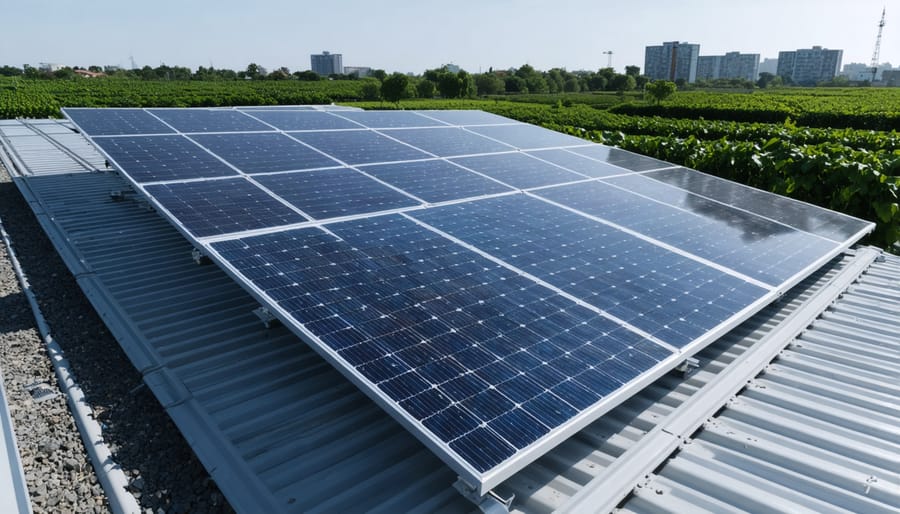
Energy-Efficient Operations
In Alberta’s agricultural landscape, energy efficiency isn’t just about cutting costs – it’s about building resilient farming operations that can withstand climate challenges while reducing environmental impact. Many local farmers are leading the way by integrating renewable energy solutions into their daily operations.
Solar panels have become increasingly common on barn rooftops and in fields, particularly in Southern Alberta where we receive abundant sunlight. These installations not only power irrigation systems but also help maintain controlled environments in greenhouses and storage facilities. For example, the Henderson Family Farm near Lethbridge reduced their energy costs by 60% after installing a 50-kilowatt solar array system.
Wind energy is another viable option, especially in areas experiencing consistent wind patterns. Small-scale wind turbines can power grain dryers, ventilation systems, and water pumps. Combined with energy storage solutions, these systems provide reliable power even during grid outages.
Energy conservation strategies are equally important. Simple measures like upgrading to LED lighting, implementing smart controllers for heating and cooling systems, and using variable frequency drives on motors can significantly reduce energy consumption. Regular equipment maintenance, proper insulation of buildings, and strategic timing of energy-intensive operations during off-peak hours also contribute to overall efficiency.
The Alberta Farm Solar Program has helped many local farmers transition to renewable energy systems. Through this initiative, farmers can access funding and technical support to implement energy-efficient solutions that work for their specific operations while building long-term sustainability.
Getting Started: Action Steps for Urban Farmers
Ready to start your urban farming journey in Alberta? Here’s your step-by-step guide to launching a climate-resilient operation:
First, connect with your local agricultural extension office through Alberta Agriculture and Forestry. They offer free consultations and can help assess your site’s potential and challenges. The Urban Farmer Alliance of Alberta also provides mentorship programs linking new farmers with experienced growers.
Start small and scale gradually. Consider beginning with a 100-square-metre plot, which allows you to test different crops and systems without overwhelming investment. Contact your municipal planning department to verify zoning requirements and obtain necessary permits for urban agriculture.
Take advantage of available resources:
– Register for the Climate-Smart Agriculture workshops offered quarterly in major Alberta cities
– Join the Alberta Urban Agriculture Network for peer support and knowledge sharing
– Apply for the Urban Agriculture Grant Program, which provides up to $5,000 for startup costs
– Download the free Urban Farming Toolkit from the City of Edmonton or Calgary’s urban agriculture portals
Essential first-year investments should include:
– Soil testing kit ($150-200)
– Basic hand tools ($300-500)
– Season extension materials like row covers ($200-300)
– Water-efficient irrigation system ($400-600)
Document everything from day one. Track weather patterns, planting dates, and crop yields using the free Canadian Agricultural Recording System (CARS). This data will prove invaluable for future planning and grant applications.
Remember, success comes from community connection. Attend monthly farmer meetups in your area, participate in seed exchanges, and consider joining a cooperative for shared resources and marketing opportunities. Your local agricultural society can connect you with these networks.
As we’ve explored throughout this article, climate-resilient agriculture isn’t just about survival – it’s about creating a thriving, sustainable future for Canadian farming. By implementing practices like drought-resistant crop selection, improved water management, and soil health optimization, Alberta farmers are already leading the way in agricultural innovation.
The path forward requires a community-driven approach, where knowledge sharing and mutual support help us all adapt to changing conditions. Remember that even small changes, like incorporating cover crops or adjusting planting schedules, can make a significant difference in your farm’s resilience.
Take advantage of local agricultural extension services, connect with fellow farmers who have successfully implemented these strategies, and consider joining regional farming networks. The tools and resources are available – now is the time to put them into action.
By working together and embracing these adaptive practices, we can build a more resilient agricultural sector that continues to feed our communities while preserving our land for future generations. Your farm’s journey toward climate resilience starts with the next step you take today.

